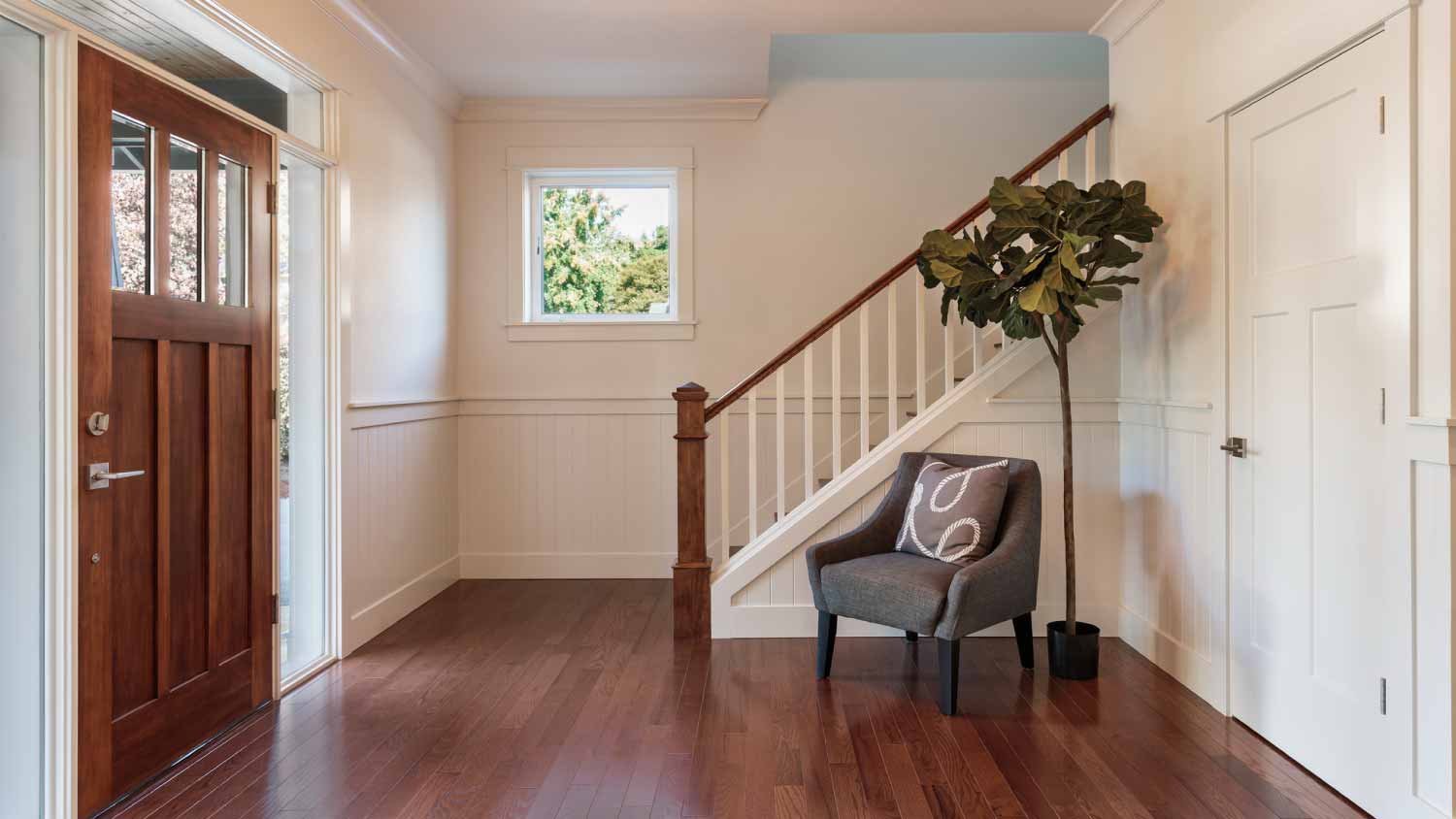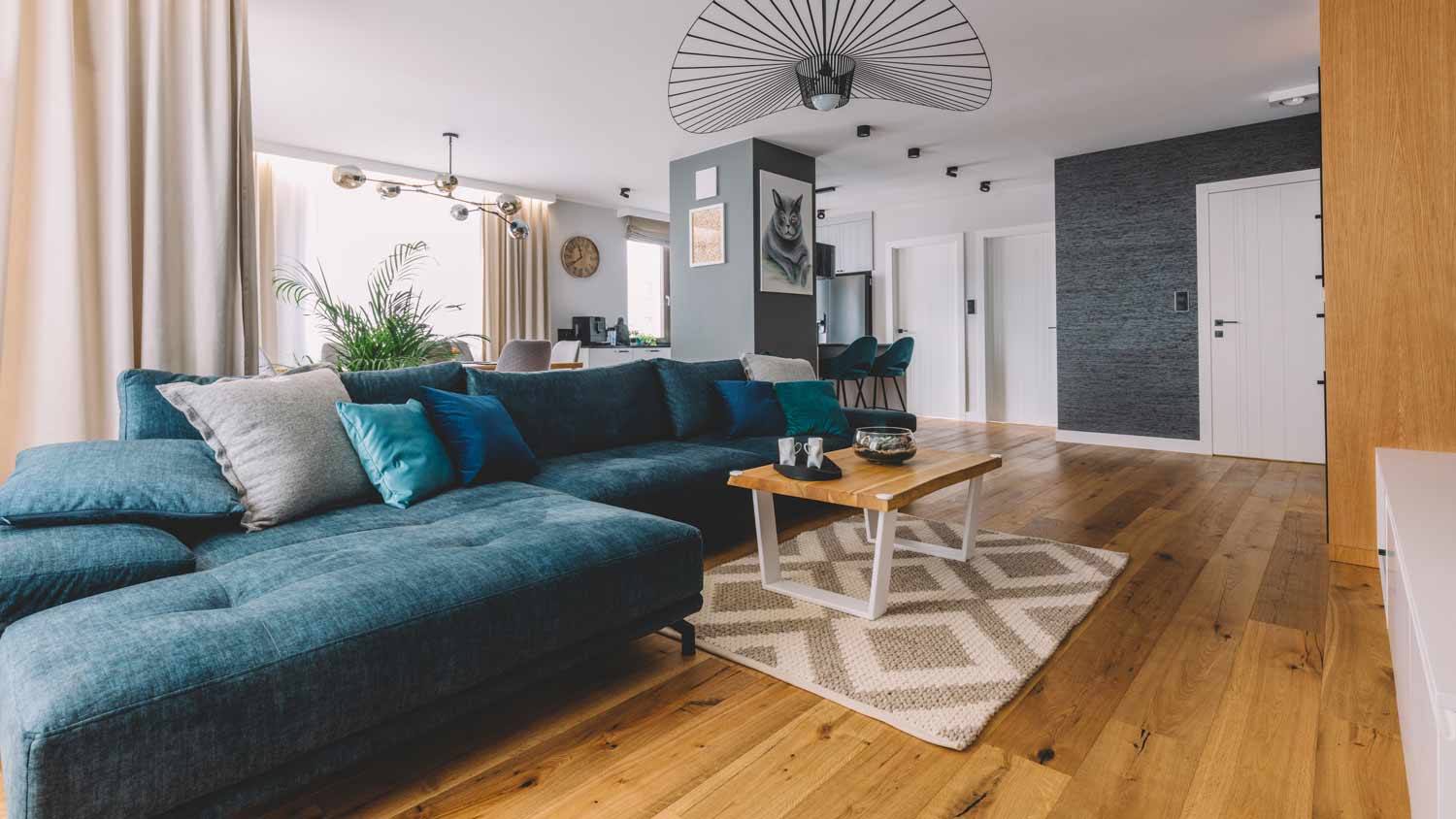What Are the Pros and Cons of Linoleum Flooring?
Your grandparents’ flooring is having a modern glow-up


Linoleum is a durable, biodegradable flooring product.
Modern linoleum can mimic a variety of colors, patterns, and natural looks.
Linoleum floors are not waterproof and are susceptible to dents and UV damage.
You’ll likely need to pay a professional to install your linoleum floors.
Linoleum flooring costs $3 to $12 per square foot.
Although hard to find nowadays, linoleum was once among the most popular home flooring options. It's recently been making a comeback thanks to its versatility and long life span. If this material is on your radar, it's worth knowing all of the pros and cons of linoleum flooring so you can make an informed choice about whether it's right for your next renovation.
What Is Linoleum Flooring?

Linoleum flooring is made from a blend of sustainable natural materials. The exact composition will vary by manufacturer, but it usually consists of linseed oil, jute, cork powder, tree resin, and wood flour.
The finished material will have a design embedded throughout. Linoleum floors in older homes often have a distinctly retro look. However, modern linoleum can be made in a practically endless array of different colors and patterns, including faux-natural designs that look like real wood or minerals.
| Pros | Cons |
|---|---|
| Durable and long-lasting | Susceptible to denting |
| Low maintenance | Low ROI |
| Wide variety of design options | Difficult to find |
| Affordable material costs | Requires professional installation |
| Scratch-resistant | Slippery surface |
| Water-resistant | Not waterproof |
| Biodegradable | Darkens or yellows from UV damage |
| Hypoallergenic |
Pros of Linoleum Flooring
Here’s what to love about this flooring type.
1. Durable and Long-lasting
Linoleum resists wear and tear very well. With proper care and maintenance, it can last for more than 40 years. It's worth noting that linoleum will change in appearance over time, aging until it requires replacement.
2. Low Maintenance
Linoleum flooring requires little maintenance and is easy to clean with a broom and mop. Stains can be tackled using a mild detergent or linoleum-specific cleaning solution, and periodic sealing is also required to help prevent scratches. Dust and pollen rest on the surface and are easily swept up, so linoleum is also hypoallergenic.
3. Design Variety
Modern linoleum flooring is manufactured using advanced printing techniques that produce just about any color or pattern on tiles and planks of any size or shape. Linoleum designs can mimic other popular flooring styles, such as hardwood, stone, or ceramic tile, at a fraction of the cost.
4. Affordable Material Costs
The cost of linoleum flooring ranges from $3 to $12 per square foot, putting it on par with carpet, laminate, and vinyl. The lower flooring material cost makes it more affordable than tile, stone, or natural hardwood.
5. Biodegradable
Linoleum is an eco-friendly flooring choice made from non-toxic, renewable materials that don't release volatile organic compounds (VOCs) into your home. It's biodegradable, unlike vinyl, which tends to be made using petroleum-based products.
Cons of Linoleum Flooring

As with all flooring, linoleum has a few drawbacks.
1. Susceptible to Damage
Despite its long-lasting durability, linoleum isn't invincible. It's particularly susceptible to denting from heavy furniture and UV damage in the form of unsightly dark or yellow patches. Removing linoleum flooring is also tricky when it does get damaged.
2. Low ROI
While linoleum has come a long way in recent years, its reputation hasn’t caught up. Linoleum is not heavily marketed, and buyers may still see it as outdated even though it’s comparable to popular flooring options like vinyl. If you choose linoleum, you'll get the best return on your investment if you go for a contemporary style.
3. Requires Professional Installation
Linoleum comes in large sheets that are not easy to DIY like smaller vinyl or laminate pieces. While you could learn how to install linoleum flooring yourself, it's difficult. This means that you're more likely to hire a local flooring pro for installation, adding professional labor to your overall cost.
4. Not Waterproof
Linoleum can resist moisture from occasional spills for a short time, but it's not waterproof. It will warp and swell over time if exposed to standing water, making it a risky choice in bathrooms, kitchens, or basements.
Alternatives to Linoleum Flooring
Linoleum flooring is not among the most popular flooring options on the market. Several other manufactured hard surface products achieve a similar look and function, and these alternatives are often even confused with linoleum:
Luxury vinyl plank (LVP)
Waterproof flooring
Is Linoleum Flooring Right for You?
Linoleum flooring is a long-lasting investment that can resist decades of wear with relatively little maintenance. If you're interested in an affordable, damage-resistant surface with unique retro appeal, linoleum is a good choice. However, it's not waterproof and therefore not ideal in bathrooms or basements where standing water is often a risk.
Frequently Asked Questions
People never fully stopped using linoleum, but it lost popularity due to the rise of more affordable and customizable flooring options such as vinyl floor tiles. Linoleum came to be viewed as a cheap-looking, outdated design choice in comparison to these new competitors on the market. Linoleum is still available today, but it is not marketed heavily.
When comparing vinyl flooring and linoleum, you should consider where you’re installing the floors to decide which is better. Vinyl flooring is a safer option in bathrooms, kitchens, mudrooms, and basements due to its superior moisture resistance compared to linoleum flooring. This is especially true of some newer vinyl products that claim to be fully waterproof.
Linoleum flooring doesn’t always need an underlayment since it has built-in backing. However, you’ll still need to ensure that your existing floor or subfloor is level with no pocks, bumps, or other imperfections. If you fail to fix these, you’ll notice it later, and your linoleum may develop cracks.
No, not all linoleum floors have asbestos. However, some linoleum floors in older homes do contain asbestos, especially if the floors were produced and installed before 1980. Asbestos was added to both linoleum and vinyl flooring products before being phased out of manufacturing in the 1980s and eventually banned just a few years ago.

.jpg?impolicy=leadImage)













